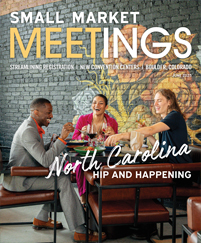
Whether it is a ski club testing the slopes, a reunion of Korean War veterans or a gathering of antique car collectors, the SMERF meeting market is a wide-ranging and vital one to second-tier and smaller cities.
SMERF stands for social, military, education, religious and fraternal meetings. In some markets, the religious and military segments have grown so large that they stand on their own, and convention and visitors bureaus dedicate sales staff to them.
In cities and suburbs where corporate meetings and business travelers keep hotels occupied on weekdays, SMERF business, which is predominantly weekend business, can fill rooms Friday through Sunday.
Other cities make the SMERF market a primary focus because it is a good fit between the market’s needs and the city’s offerings. For example, in Central Oregon, the Central Oregon Visitors Association in Bend, Ore., has worked with the Mount Bachelor Ski Resort to attract ski clubs from across the country.
As corporate meeting business has fallen off in the past 18 months, a number of CVBs have stepped up their marketing to the SMERF segment, seeing it as a logical go-to market in times of economic turmoil.
In Daytona Beach, Fla., the SMERF market has always been primary, especially the religious segment. The Daytona Beach Area CVB dedicates a sales person to the religious market; Linda McMahon is the sales manager for the remaining categories that fall under the SMERF category.
“The SMERF market has always been big,” said McMahon. “What we have seen with the economy is that they have remained strong. We can have confidence in them meeting.”
CVBs take efforts up a notch
Even bureaus that have targeted the market for years say they are taking their efforts up a notch. The Greater Wilmington, Del., CVB has made the SMERF market a focus for the past four years, but it recently began attending additional trade shows such as Rejuvenate, which is aimed at meeting planners of religious events. The bureau is also advertising in trade publications for the SMERF market.
The Central Pennsylvania CVB in State College, Pa., entices SMERF planners in a couple of ways. It is offering a $5,000 incentive for groups that meet certain requirements. It has also showcased one of its local specialties by hosting ice cream socials, supplying plenty of tasty ice cream made at Penn State’s well-known Creamery.
Bloomington goes to new trade shows
Destination Bloomington, which represents the suburb that’s home to the Mall of America on the edge of Minneapolis, will attend two new trade shows this year. One targets the fraternal market, the other the military, according to sales manager Keith Otzen.
The bureau is also offering a discount, ranging from 30 percent off for meetings held January through March to 20 percent off meetings held June through July. The business must be new and encompass a minimum of 25 rooms.
The bureau has held some familiarization trips for planners and has planned a true Minnesota-style FAM — an ice-fishing adventure —for early February. A military meeting planner from Chicago who plans to attend can hardly wait, Otzen said. If he opts to book his reunion in Bloomington, it will fill 100 rooms a night at the destination.
Fairfax County, Va., on Washington’s edge, is a heavy corporate market, home to nine Fortune 500 companies and dozens of other companies that are household names. Hotels in the area have no problem filling their rooms Monday through Thursday.
“The challenge is filling Friday through Sunday. Every weekend is effectively the slow season for us,” said Dean Miller, a national sales manager who handles the SMERF market for Visit Fairfax. “The SMERF market is very, very important to us, given the nature of the destination.”
Working the SMERF market is less of a challenge for destinations that “have a beach or Disneyland right down the street,” said Miller. Nonetheless, Fairfax County has had its successes, because it has been assertive. “We have been proactive in going after the SMERF market.”
Family groups a good fit for Estes Park
In Estes Park, Colo., the SMERF market has always been strong, a good fit for a city that’s home to Rocky Mountain National Park, a natural draw for family-oriented social events and fraternal events as well as religious groups.
Thanks in part to the reliability of SMERF groups, Estes Park, and for that matter, much of Colorado, is experiencing a decrease in visitation that is in the single digits compared with double-digit drops in other parts of the country, according to Julie Nikolai, director of group sales for the Estes Park CVB.
“The social and fraternal markets are still going strong, but what we are seeing is that they are starting to meet more economically,” said Nikolai. “Some that used to stay two nights now come up for two days and eliminate one night o their stay.”
SMERF planners are also asking more often for money-saving tips, according to Nikolai. Top on planners’ list are ways to save money on meals.
She’s come up with a number of ideas. Nikolai suggests having a dinearound at mid-price restaurants (there are more than 70 eateries in Estes Park) instead of a banquet; instead of a luncheon at the conference center, she suggests that planners give attendees extra time at lunch and have them dine on their own or provide a less-expensive box lunch.
She’s heard no complaints from her meeting venues, even though some have lost some food and beverage revenues because of her suggestions. “I’d rather have the meeting venue lose one meal and have the dollars stay in Estes Park and find a way to cut $10 (per person) out of the budget rather than have them leave a day early.”
Providing money for wheels reels in business
The Greater Wilmington, Del., CVB has had good response to it’s a transportation incentive, and it is offering it for a second year. Several SMERF groups have taken advantage of the program, which offers from $2,600 to $20,000 for transportation, depending on the number of room nights generated.
This July about 125 members of the Gamble family will have their reunion in Wilmington and because of the transportation incentive, they’ll be able to transport family members to off-site events at the Wilmington Western Railroad and Blue Rocks baseball park.
The incentive also helped Greater Wilmington win the bid for the USS Mills DER 383, which will bring about 200 people to Wilmington for five days in October.
In Daytona Beach, McMahon has seen SMERF groups exhibit more flexibility on dates for meetings than in the past to save money. “I’m seeing groups that have always had an event at a certain time of the year willing to change for affordability.”
The down economy had made it tougher in some ways for Daytona to attract SMERF business. It has always vied with nearby Orlando, which has the advantages of good air service and Disney World, and with hotels dropping rates to “almost being ridiculous,” it has been hard in some cases for Daytona to compete with the larger city.
But groups that have gone to Orlando for many years are starting to “breathe new life into their programs,” said McMahon, and they are finding Daytona attractive, between its beach and the Daytona 500 Experience, an interactive NASCAR attraction.
Among Daytona’s upcoming SMERF meetings is District 35 Lions Club of Florida and the Bahamas, which will meet in the city in April. Because the Lions Club planner was concerned about attendance for the gathering, the Daytona Beach CVB helped build interest in the meeting by attending the club’s convention last year.
CVB staff and area representatives staffed a booth at the club’s convention, handing out information as well as door prizes such as spa gift certificates and tickets to the Daytona 500 Experience that had been donated by area businesses. The bureau will also run an ad in the Lions magazine in March.
Lower hotel rates mean more business
The economy has actually had advantages for Fairfax County in terms of SMERF business. As hotel rates have fallen, the area has become more affordable. “We are definitely seeing inquiries from groups that have never thought they could afford us in the past,” said Miller.
Military groups are a key market for his area. Monuments and museums with military themes are abundant in the county and in nearby Washington; another will soon be under way with the ground breaking for the National Museum of the U.S. Army this year in Fairfax County.
Because of its suburban hotels, Fairfax County has become a logical choice for car collector clubs, which need large, free parking lots to display their cars, and for dog shows, which require hotels with dog friendly policies and grassy areas.
The bureau has also had some unexpected successes. It is about to host the Adult Fans of Lego (AFOL) for the third time.
It attracted the group, which gathers to build monumental structures — such as a 16-foot replica of the Burj Khalifa, the world’s tallest building in Dubai — and then raises money for the organization by opening exhibits of members’ work to the public.
AFOL first came to Fairfax County in 2006. Before then, it had met on a college campus, where its lodging, dining and exhibits were scattered about. The sales team at Visit Fairfax showed the group how it could affordably put its convention under one roof at an area hotel. It also helped the group get publicity for its exhibit.
“They were so pleased with the assistance we provided that they made our logo in Legos,” said Miller. The Lego logo hangs on his office wall.
Diversity makes SMERF a growth market
Because of its diversity, Fairfax County views SMERF meetings as a growth market.
Its next target is family reunions, where it hopes to replicate the success it has had with military reunions.
Last year, the bureau had its first family reunion workshop and it plans to have another this year.
About 60 planners attended and the bureau has already booked three reunions as a result.
“With the SMERF market, you have to look at the markets where you have an innate advantage,” said Miller.












